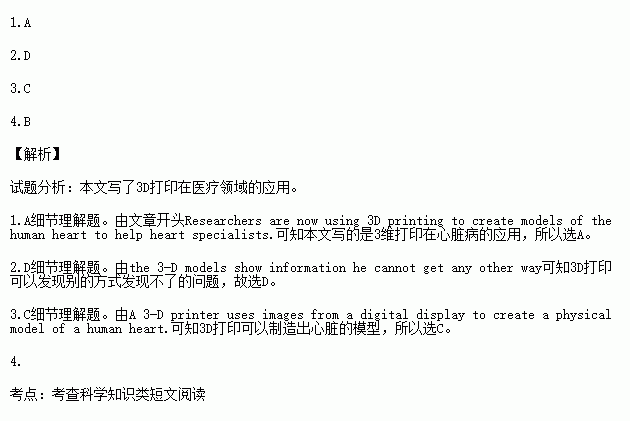题目内容
Researchers are now using 3D printing to create models of the human heart to help heart specialists. The heart doctors can use the models to better help patients before an operation.
Dr. Bramlet, a children’s heart expert at the University of Illinois College of Medicine, says the 3-D models show information he cannot get any other way.
“And so what we’ve done with the printed models? We’ve pulled it out of the screen so that you can actually hold it in your hand and evaluate the anatomy(解剖).”
A 3-D printer uses images from a digital display to create a physical model of a human heart. Matthew Bramlet says doctors can use the model to understand the anatomy.
Pictures from medical tests like CAT scan or MRI are sent to a 3-D printer to create a heart in a plaster(石膏)form. The printer then constructs the heart, thin layer by thin layer. Dr. Bramlet says the model matches the real heart in every detail. “When we’re done with the model and made our decision, we want to be able to go back to the source image and confirm those findings, he says.
Dr. Bramlet has built model hearts for different kinds of heart operations. All of the operations were successful. In his first case, digital images showed only one tiny hole in a baby’s heart. But, the 3-D printed model showed several defects or problems that the baby was born with. Dr. Bramlet says those defects could not be seen easily in the images. The heart surgeon was able to change the type of surgery for the patient based on the 3-D model. He added that 3-D heart models saves time during heart operations.
Kathy Magliato is a heart surgeon at Saint John’s Health Center in Los Angeles. She welcomes the new technology. She says it could help her make better decisions before she operates on the hearts of her patients.
“I can then take this very complicated structure before the operation and I can hold it in my hand and plan an operation around what I’m seeing, touching and feeling. That to me is what can potentially change the game in an operation and save lives.
Dr Bramlet continues to research the technology. He is working with the National Institutes of Health to build a 3-D library that includes heart models and images that others can use.
1.Whats the main idea of the passage?
A. The application of 3-D printing in heart operations
B. The development of 3-D technology.
C. The difficulties of heart operations.
D. Heart operations with the help 3-D models.
2.What is the biggest advantage of 3-D models in the diagnose of heart problems?
A. Surgeons can see, touch and feel the 3-D models.
B. They can help surgeons save time.
C. They can be made exactly like the hearts.
D. They can help discover the otherwise hidden heart problems.
3.Which of the following statements is TRUE?
A. The 3-D model can be taken out of a screen.
B. CAT scan and MRI are no longer needed.
C. The 3-D model is an exact copy of the heart.
D. Digital images are not reliable in heart operations.
4.What can we infer from the passage?
A. Digital images will mislead heart surgeons.
B. More patients will benefit from the 3-D technology.
C. Heart operations will never fail with 3-D models.
D. Surgeons cannot operate on hearts without 3-D models.
 开心蛙状元作业系列答案
开心蛙状元作业系列答案 课时掌控随堂练习系列答案
课时掌控随堂练习系列答案 一课一练一本通系列答案
一课一练一本通系列答案 浙江之星学业水平测试系列答案
浙江之星学业水平测试系列答案
